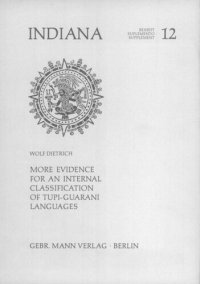
Ebook: More evidence for an internal classification of Tupi-Guarani languages
Author: Wolf Dietrich
- Genre: Linguistics // Linguistics
- Tags: Linguistics, Lingüística, Historical Linguistics, Lingüística Histórica, Dialectología, Dialectology, Tupi, Tupi languages, Guarani, Guarani languages, Amazonian languages, Familia Tupí-Guaraní, Tupi-Guarani Language Family, Lenguas peruanas, Peruvian Languages, Brasil, Languages from Brazil, Paraguay, Tupinamba, Lingua Geral, Amazonian Linguistics, Lingüística amazónica
- Series: Indiana, 12, Beiträge zur Volker und Altertumskunde Spachen- Sozial- und Geschichtsforschung des Indianischen Lateinamerika
- Year: 1990
- Publisher: Ibero-Amerikanisches Institut – Preußischer Kulturbesitz
- City: Berlin
- Language: English
- pdf
In this paper I will consider linguistic e v i d -
ence from phonology and morphology for internal
classification of Tupi-Guarani. Lexical coherence
has been shown by various authors, including L e m -
le ( 1 9 7 1 ) , although her first aim was a phonological
classification. Leite (1982) studied the place of
Tapirapé within the Tupi-Guarani family on the
basis of vowel changes. It is evident that the
grouping of languages depends on the criteria a p -
plied. Rodrigues, for instance, showed that the
traditional division of the family into Tupi and
Guarani languages, which was founded on the c o n -
servation of - s - in Tupi and its change to - h - in
Guarani, is not sufficient for a genetic c l a s s i f i c a -
tion and that lexical comparison leads to quite
different results (Rodrigues 1964:103). Rodrigues'
recently published paper on the "Internal r e l a t i o n -
ship within the Tupi-Guarani language family" ( R o -
drigues 1 9 8 4 / 8 5 ) is based on evidence from h i s t o r i -
cal phonology.
1.2.2. Ultimately, the purpose of the present study
will be a genetic grouping, too, because the c r i t e -
ria for the comparison of phonetic, phonological,
and morphological properties were mostly chosen
according to the principle of conservation or loss
of a feature of one of the "classical" languages of
the family, that is, of Tupinambá (Old Tupi) and
Avañe'é (Modern Paraguayan Guarani). Questions of
genetic relationship are also involved when we consider innovations unknown in one of the " c l a s -
sical" languages
ence from phonology and morphology for internal
classification of Tupi-Guarani. Lexical coherence
has been shown by various authors, including L e m -
le ( 1 9 7 1 ) , although her first aim was a phonological
classification. Leite (1982) studied the place of
Tapirapé within the Tupi-Guarani family on the
basis of vowel changes. It is evident that the
grouping of languages depends on the criteria a p -
plied. Rodrigues, for instance, showed that the
traditional division of the family into Tupi and
Guarani languages, which was founded on the c o n -
servation of - s - in Tupi and its change to - h - in
Guarani, is not sufficient for a genetic c l a s s i f i c a -
tion and that lexical comparison leads to quite
different results (Rodrigues 1964:103). Rodrigues'
recently published paper on the "Internal r e l a t i o n -
ship within the Tupi-Guarani language family" ( R o -
drigues 1 9 8 4 / 8 5 ) is based on evidence from h i s t o r i -
cal phonology.
1.2.2. Ultimately, the purpose of the present study
will be a genetic grouping, too, because the c r i t e -
ria for the comparison of phonetic, phonological,
and morphological properties were mostly chosen
according to the principle of conservation or loss
of a feature of one of the "classical" languages of
the family, that is, of Tupinambá (Old Tupi) and
Avañe'é (Modern Paraguayan Guarani). Questions of
genetic relationship are also involved when we consider innovations unknown in one of the " c l a s -
sical" languages
Download the book More evidence for an internal classification of Tupi-Guarani languages for free or read online
Continue reading on any device:

Last viewed books
Related books
{related-news}
Comments (0)